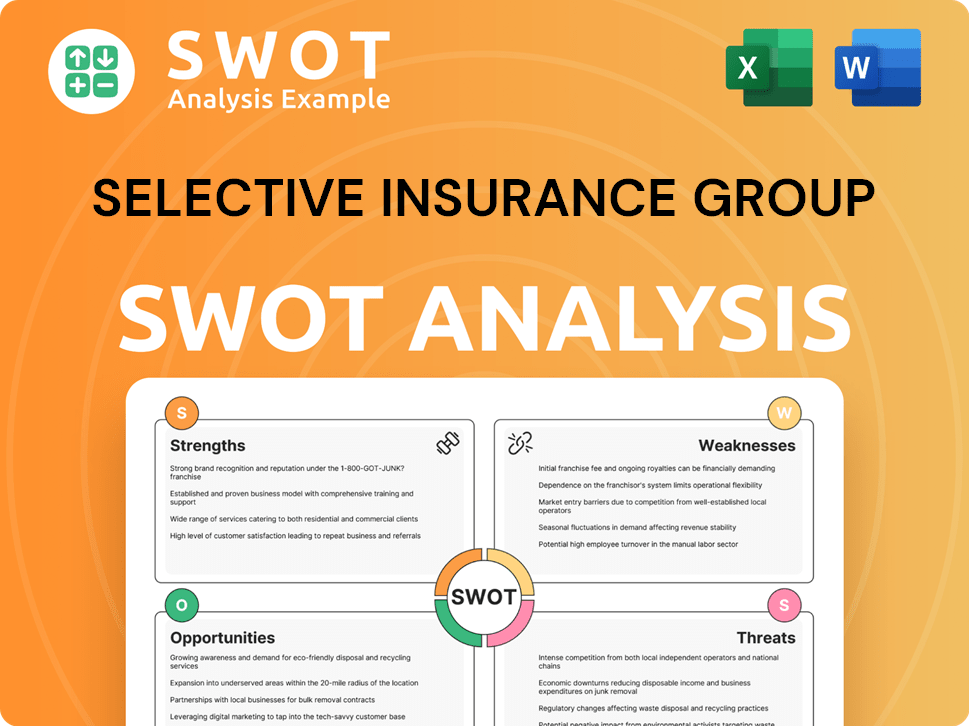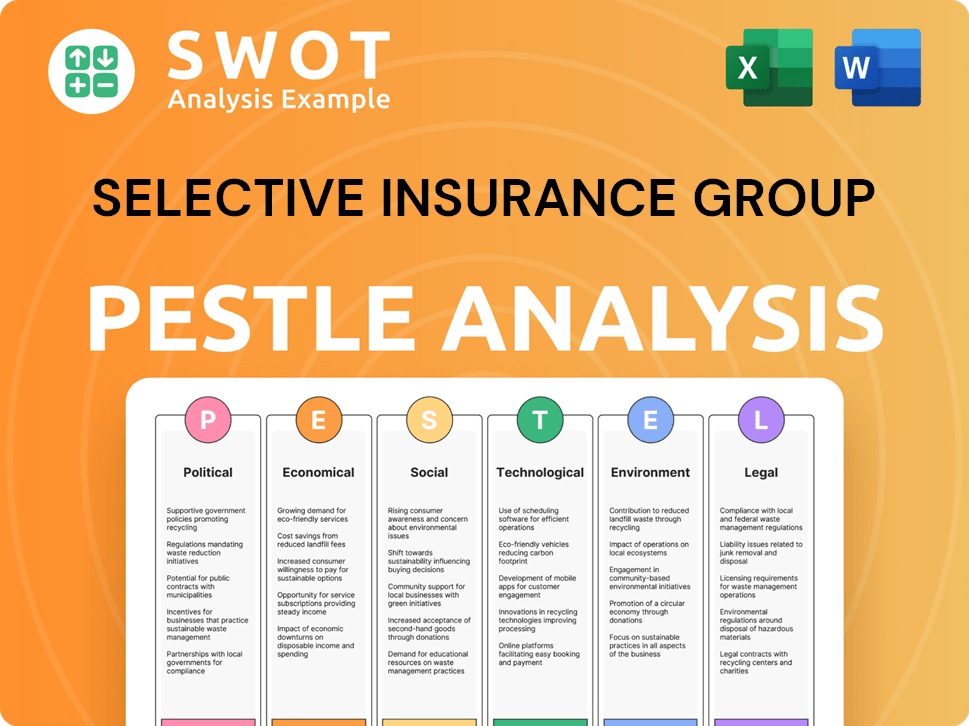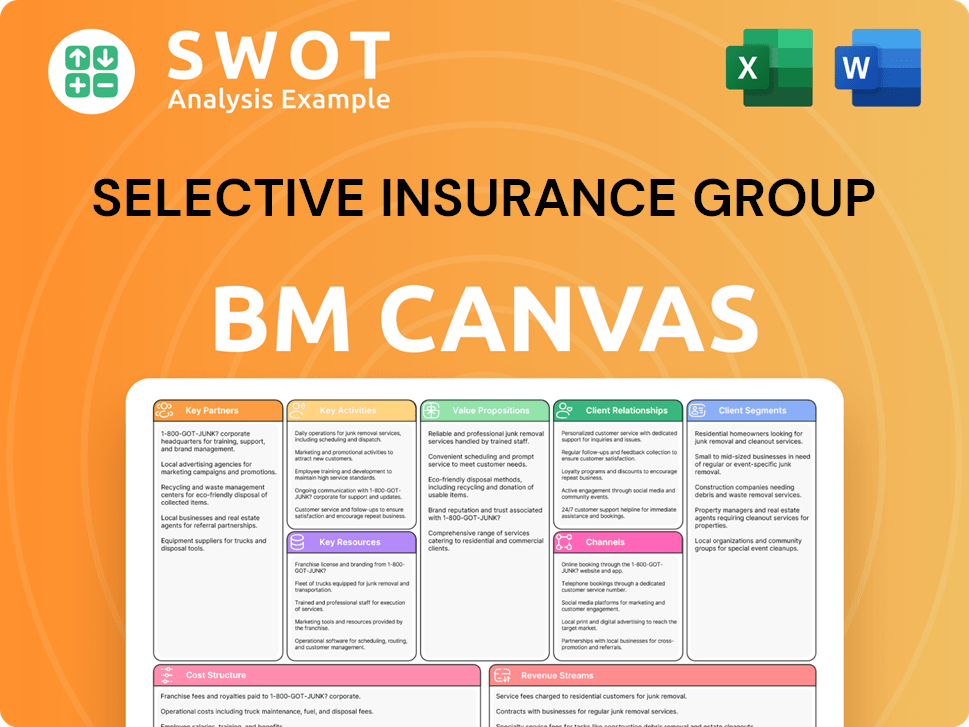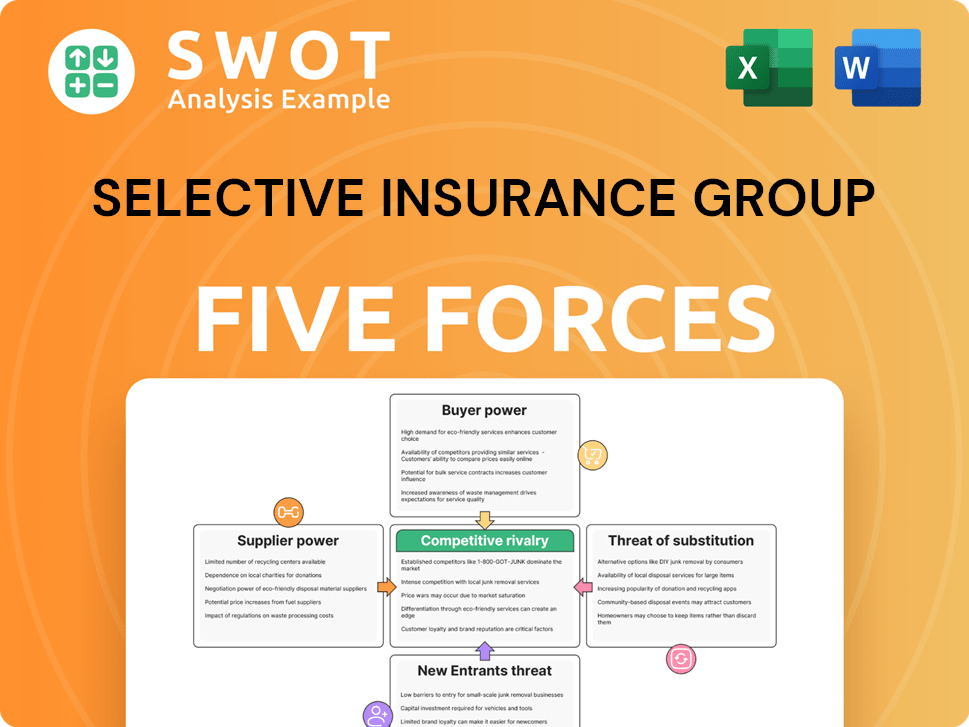Selective Insurance Group Bundle
Who Really Controls Selective Insurance Group?
Understanding the ownership of Selective Insurance Group is key to unlocking its strategic moves and future prospects. This publicly traded company, a major player in the property and casualty insurance sector, has a fascinating ownership story. Uncover the forces shaping Selective Insurance Group SWOT Analysis and its trajectory in the competitive insurance market.

From its humble beginnings in 1926 as Selected Risks Insurance Company, Selective Insurance Company has evolved significantly. Exploring Selective Insurance ownership, including its key shareholders and the influence they wield, provides crucial insights into the company's governance and strategic direction. Discover the impact of institutional investors and public shareholders on Selective Insurance Group's operations and financial performance, including its impressive $4.98 billion in trailing twelve-month revenue as of March 31, 2025.
Who Founded Selective Insurance Group?
The story of Selective Insurance Group begins in 1926, when Daniel L.B. Smith, along with a group of colleagues, established the company. Initially named Selected Risks Insurance Company, the venture was launched with an investment of $20,000, marking the beginning of what would become a significant player in the insurance industry. Dr. L.B. Hoagland was the first president of the company.
Smith's background in operating a chain of general stores in Sussex County, NJ, provided him with a unique perspective that shaped the company's early direction. His personal experience with a runaway horse incident highlighted the need for reliable insurance, which spurred his entry into the insurance business. This personal connection underscored the importance of the services the company would provide.
In 1929, Selected Risks Fire Insurance Company was created to offer auto material damage and property fire coverages. The company expanded its offerings in 1931 to include general liability, workers' compensation, property, and municipal government insurance. Following Dr. Hoagland's death in 1936, Daniel L.B. Smith took over as president, further cementing his vision for the company. Early agreements focused on establishing the core business and expanding its product offerings to meet the growing demands of policyholders.
While specific details on initial equity splits or the exact number of shares held by founders and early backers are not publicly available, the founding investment and the sequential establishment of related insurance entities indicate a controlled initial ownership structure driven by Smith and his close associates. The early focus was on establishing a strong foundation. The company's history shows a strategic approach to growth and expansion, with a clear vision from its founders. For more insights, you can explore the Growth Strategy of Selective Insurance Group.
- Daniel L.B. Smith was the founder of Selective Insurance.
- The initial investment was $20,000.
- Selected Risks Fire Insurance Company was formed in 1929.
- The company expanded its coverage in 1931.
Selective Insurance Group SWOT Analysis
- Complete SWOT Breakdown
- Fully Customizable
- Editable in Excel & Word
- Professional Formatting
- Investor-Ready Format

How Has Selective Insurance Group’s Ownership Changed Over Time?
The ownership of Selective Insurance Group, a publicly traded entity under the stock symbol SIGI on NASDAQ, is primarily composed of institutional investors. As of the latest available data, institutional investors hold a significant portion of the company's stock. This ownership structure, with its emphasis on institutional investors, plays a crucial role in shaping the company's strategic direction and financial performance. Understanding the dynamics of Selective Insurance ownership is key for investors and stakeholders alike.
The evolution of Selective Insurance's ownership structure has been influenced by various factors, including market trends and strategic decisions. The company has experienced stock splits, such as the 2-for-1 split on February 21, 2007, which have impacted the number of outstanding shares and, consequently, the ownership distribution. The high percentage of institutional ownership indicates confidence in the company's long-term prospects, influencing its decision-making processes and stock valuation. Investors interested in Selective Insurance stock should monitor these shifts closely.
| Ownership Category | Percentage of Ownership (Approximate) | Notes |
|---|---|---|
| Institutional Investors | 74.02% | Includes firms like BlackRock and Vanguard. |
| Insiders | 0.83% | Individuals within the company. |
| Public Companies and Individual Investors | 25.16% | Represents the remaining ownership. |
Key institutional shareholders in Selective Insurance Group include BlackRock, Inc., Vanguard Group Inc, and Fmr Llc. As of December 31, 2024, Vanguard Group Inc. held 6,620,901 shares. The substantial holdings by these institutional investors highlight their significant influence on the company. For further insights, consider exploring the Competitors Landscape of Selective Insurance Group to understand its position within the insurance industry.
Selective Insurance Group is primarily owned by institutional investors, reflecting confidence in its future. The company's stock has been influenced by market trends and strategic decisions, impacting ownership. Understanding the ownership structure is crucial for stakeholders.
- Institutional investors hold a significant majority of the shares.
- Key shareholders include BlackRock, Vanguard, and others.
- Stock splits have affected the outstanding shares and ownership distribution.
- Monitoring ownership changes is essential for investors.
Selective Insurance Group PESTLE Analysis
- Covers All 6 PESTLE Categories
- No Research Needed – Save Hours of Work
- Built by Experts, Trusted by Consultants
- Instant Download, Ready to Use
- 100% Editable, Fully Customizable

Who Sits on Selective Insurance Group’s Board?
The current board of directors of Selective Insurance Group, Inc. is pivotal in the company's governance. John J. Marchioni holds the positions of CEO, President, and Chairman. In 2020, Gregory Murphy moved from chief executive officer to executive chairman, with John Marchioni taking on the roles of president and chief executive officer. While specific details about all board members and their representation are not readily available in the provided search results, the leadership structure is clear.
The leadership team at Selective Insurance Company is responsible for guiding the strategic direction and overseeing the operations of the business. Understanding the composition and roles of the board of directors is crucial for investors and stakeholders. For more information about the company's background, you can read Brief History of Selective Insurance Group.
| Board Member | Title | Notes |
|---|---|---|
| John J. Marchioni | CEO, President, and Chairman | Current leadership role |
| Gregory Murphy | Executive Chairman | Transitioned in 2020 |
The voting structure for Selective Insurance Group, as a publicly traded company, generally follows a one-share-one-vote principle. The company's definitive proxy statement from March 27, 2024, indicates that for the election of directors, a nominee is elected if the votes cast for their election exceed the votes cast against them. Proposals for advisory approval of executive compensation and the 2024 Omnibus Stock Plan also require an affirmative vote of a majority of votes cast. Institutional investors, holding a significant portion of the company's stock (approximately 74.02% or 82.88%), can significantly influence management decisions. FMR LLC increased its ownership to 8.99% as of November 12, 2024.
The board of directors, led by John J. Marchioni, plays a critical role in Selective Insurance Group's governance. The voting structure adheres to a one-share-one-vote principle. Institutional investors hold a substantial portion of the company's stock, influencing management decisions.
- John J. Marchioni serves as CEO, President, and Chairman.
- Voting follows a one-share-one-vote principle.
- Institutional investors hold a significant percentage of shares.
- FMR LLC increased its ownership to 8.99% as of November 12, 2024.
Selective Insurance Group Business Model Canvas
- Complete 9-Block Business Model Canvas
- Effortlessly Communicate Your Business Strategy
- Investor-Ready BMC Format
- 100% Editable and Customizable
- Clear and Structured Layout

What Recent Changes Have Shaped Selective Insurance Group’s Ownership Landscape?
Over the past few years, Selective Insurance Group has seen shifts in its ownership structure. A significant trend is the increase in institutional ownership, with roughly 82.88% of the stock held by institutional investors, including hedge funds. This reflects a broader industry pattern of institutional consolidation. In the fourth quarter of 2024, several institutions increased their stakes, such as Apollon Wealth Management LLC, which increased its position by 24.6%.
Further illustrating these ownership dynamics, Empowered Funds LLC acquired a new stake, and Van ECK Associates Corp raised its holdings by 27.0%. Rhumbline Advisers also increased its holdings by 3.0% during the same period. These movements highlight the ongoing interest and confidence from institutional investors in the company. Corporate insiders collectively own 1.50% of the company's stock.
In terms of leadership, Brenda M. Hall, Executive Vice President and Chief Operating Officer, Standard Lines, announced her retirement, effective January 5, 2026, after 24 years with the company. Additionally, insider activity was reported, with CAO Anthony D. Harnett selling 1,352 shares in April 2025, reducing his position by 7.82%. Selective Insurance Group's financial health remains robust, with a strong capital base of $3.1 billion in equity and a debt-to-capital ratio of 14.0% as of the end of 2024.
Selective Insurance Group reported strong Q1 2025 financial results, with net income per diluted share of $1.76. Return on Common Equity (ROE) was 14.4%, a significant improvement from 2024. Net premiums written increased by 7% to $1.24 billion in Q1 2025.
The company is targeting a 3% market share in its existing footprint over the long term, up from approximately 1.5% currently. The 2024 annual report, released in February 2025, highlighted expansion into five additional states for its Standard Commercial Lines business.
Selective Insurance Group Porter's Five Forces Analysis
- Covers All 5 Competitive Forces in Detail
- Structured for Consultants, Students, and Founders
- 100% Editable in Microsoft Word & Excel
- Instant Digital Download – Use Immediately
- Compatible with Mac & PC – Fully Unlocked

Related Blogs
- What are Mission Vision & Core Values of Selective Insurance Group Company?
- What is Competitive Landscape of Selective Insurance Group Company?
- What is Growth Strategy and Future Prospects of Selective Insurance Group Company?
- How Does Selective Insurance Group Company Work?
- What is Sales and Marketing Strategy of Selective Insurance Group Company?
- What is Brief History of Selective Insurance Group Company?
- What is Customer Demographics and Target Market of Selective Insurance Group Company?
Disclaimer
All information, articles, and product details provided on this website are for general informational and educational purposes only. We do not claim any ownership over, nor do we intend to infringe upon, any trademarks, copyrights, logos, brand names, or other intellectual property mentioned or depicted on this site. Such intellectual property remains the property of its respective owners, and any references here are made solely for identification or informational purposes, without implying any affiliation, endorsement, or partnership.
We make no representations or warranties, express or implied, regarding the accuracy, completeness, or suitability of any content or products presented. Nothing on this website should be construed as legal, tax, investment, financial, medical, or other professional advice. In addition, no part of this site—including articles or product references—constitutes a solicitation, recommendation, endorsement, advertisement, or offer to buy or sell any securities, franchises, or other financial instruments, particularly in jurisdictions where such activity would be unlawful.
All content is of a general nature and may not address the specific circumstances of any individual or entity. It is not a substitute for professional advice or services. Any actions you take based on the information provided here are strictly at your own risk. You accept full responsibility for any decisions or outcomes arising from your use of this website and agree to release us from any liability in connection with your use of, or reliance upon, the content or products found herein.